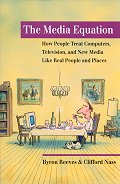The thesis of the book is summed up in its subtitle: people treat computers like people, and mediated experiences (ones experienced through a medium such as television) like real experiences. The main content of the book is the description of a series of careful experiments designed to test this observation. Experiments from psychology that demonstrate aspects of social behaviour are examined, and replicated with one of the actors replaced by a computer, or the experience replaced by a mediated experience. The prediction is that the results will nevertheless be unchanged: this is borne out by the experimental results.
Some of the ways people treat computers like people is that they respond well to being flattered by them, and are polite to them. In exactly the same we tend not to criticise people to their faces, the experimental subjects tended not to criticise computers to their "faces". The authors argue that the way people automatically and unconsciously respond to computers should affect the way that computers are themselves designed to interact with people:
Early on we get an explanation of why the Media Equation result shouldn't be that surprising. After all, we haven't had much of a chance to learn any better:
And this reaction happens very easily. The computer doesn't need a fancy hi-tech user interface, or any "helpful" little animated icons, to give it a "human face", in order to be treated like a person. A black and white text interface is all it takes.
In some ways this result shouldn't come as too much of a surprise: politeness is automatic, as anyone who has bumped into a lamppost and absentmindedly apologised to it will know. (Surely I'm not the only one to do this?) What really is surprising however, is how unconscious most of the Media Equation behaviour is: the experimental subjects consistently denied they were behaving in these ways (demonstrating that introspection is not a valid way to discover these behaviours).
Many of the experiments are nothing to do with computers, however. They are concerned with the way people react to mediated experiences, mostly through a TV or cinema screen. Some of these experiments are incredibly simple, such as putting differing labels on top of two otherwise identical TVs, the specialist TV labelled "News Television" or "Entertainment Television" as appropriate, and the generalist TV labelled "News and Entertainment Television". Not only did participants rate the specialist better on (their identical) content, but also:
Personally I find all these results more a rather depressing statement about humanity's intelligence in general, than an interesting psychological result about mediated experiences. What use our intelligence if so may of our responses are subconscious, unrecognised, and objectively silly?
Other mediated experiments simply involve changing the size of the picture. In reality "big" is correlated with "close" and therefore possibly with "dangerous". It's the same whether real or mediated.
This rule won't sound improbable to anyone who has watched the same film in a cinema and on the TV. I well remember flinching, along with most of the rest of the audience, the first time I saw the enormous Star Destroyer spacecraft appear overhead at the beginning of Star Wars -- the experience is nothing like as effective on the TV. However, as the authors note, but never explain or perform an experiment on, we don't react exactly the same way to real and mediated experiences. We may flinch, but we don't run away. We may gasp, or even scream in fear, but we don't phone for the police. Our conscious reactions are more discriminating. Yet they may still be influenced by our unconscious reactions:
The test scenes were all taken from action films. Are the results the same for all film genres? But in any case, I suspect I should note on my film reviews whether I saw the show at the cinema or on TV (but I draw the line at noting the size of the screen!)
One thing about the experimental setup does worry me. The idea is to take experiments from real interactions, and see how, if at all, the results change if the experience is mediated. However, consider the following description of the real world experiment to be used as a basis for a mediated one:
Note that the supposedly unmediated experiment uses pictures of faces, not real faces. It is actually mediated! Some psychologists are already assuming the results of the mediated experiments in the real world ones: they are assuming that pictures of faces are equivalent to real faces. So this might cast doubts on some of the mediated experiments, since they are not being compared with reality at all.
This minor quibble aside, the results reported here make fascinating reading. And the authors go on to suggest design criteria for systems based on these results. I particularly like the point they make about empowerment versus choice:
Indeed. Endless choice, especially between virtually indistinguishable offerings, can be simply energy-sapping constant effort.
So, read this to find out how unknowingly irrational people are, and how we might design computers to accommodate (but not to cure) that.
